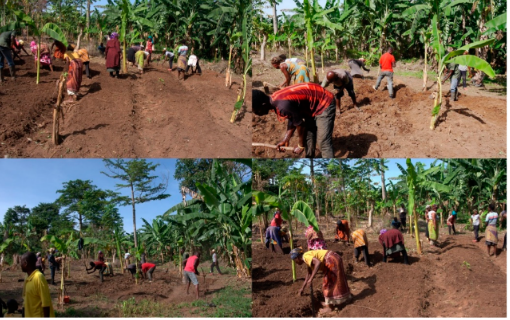NEWS
Examples of bio restoration and reforestation

In recent years, the world has seen an unprecedented level of environmental degradation due to human activity. From deforestation to habitat destruction, we have done significant damage that can’t be undone overnight. However, there is a growing movement for bio restoration and reforestation that is slowly but surely helping to reverse the damage we have done to our planet. In this article, we will explore what bio restoration and reforestation are, how they work and some examples of successful projects in this field.
What is bio restoration?
Bio restoration is the process of repairing or rehabilitating degraded ecosystems using plant life. This can be done through reforestation, which is the replanting of trees in an area where forest has been lost, or by planting native vegetation in areas where it has been removed. Bio restoration can also include the reintroduction of native animals to an area where they have been extirpated.
What is reforestation?
Reforestation is the natural or intentional restocking of an area with trees. Trees are important for many reasons. They help clean the air we breathe, provide homes for wildlife, and stabilize the soil. Reforestation can happen naturally when an area is left undisturbed long enough for trees to grow back on their own, or it can be done intentionally through planting and care.
There are many benefits to reforestation, including reducing greenhouse gases in the atmosphere, providing habitat for wildlife, and stabilizing soils. Reforestation also has a positive impact on local communities by creating jobs and improving quality of life.
Examples of bio restoration projects
1. The Saugus Sandspit Restoration Project in Massachusetts:
The Saugus Sandspit is a naturally-occurring sandbar located at the mouth of the Saugus River in Massachusetts. It is used by nesting birds, such as the endangered roseate tern, and is home to a variety of plant life.
2. The Anacostia Watershed Society’s Aquatic Garden project in Washington D.C.:
The Anacostia Watershed Society’s (AWS) Aquatic Garden revitalization project seeks to improve water quality and habitat in the Anacostia River through the creation of native plant gardens along its shoreline. AWS has installed over 20000 square feet of aquatic gardens since 2001, providing critical habitat for fish, amphibians, and other wildlife.
3. The Deer Creek Wetland Preserve near Los Angeles:
Deer Creek Wetland Preserve is a 12-acre site that was once part of a larger wetland complex that has been largely lost to development. Through bio restoration efforts, including the planting of native wetland plants, it is hoped that the preserve will provide valuable habitat for migrating birds and other wildlife.
Examples of reforestation projects
1. The Green Belt Movement: The Green Belt Movement is a reforestation project that was started in Kenya in 1977. The project aims to help control soil erosion, improve the quality of water and air, and create jobs.
2. The Global Releaf Fund: The Global Releaf Fund is a program that provides funding for tree planting projects around the world. Projects that have been funded by the Global Releaf Fund include a reforestation project in Haiti and a tree-planting project in Ethiopia.
3. Trees for the Future: Trees for the Future is an organization that helps communities plant trees to restore their environment. Some of the projects that Trees for the Future has worked on include planting trees in Senegal to combat desertification and planting trees in Guatemala to provide food and income for families.
The benefits of bio restoration and reforestation
There are many benefits of bio restoration and reforestation, including environmental, economic, and social benefits.
Environmental benefits:
-Bio restoration and reforestation can help to restore ecosystems that have been degraded or damaged by human activity.
-It can help to increase the amount of carbon dioxide sequestered in the atmosphere, which can help to mitigate climate change.
-It can also help to improve air and water quality.
Economic benefits:
-Bio restoration and reforestation can create jobs in the forestry and conservation industries.
-It can also generate income from the sale of timber and other forest products.
-Bio restoration and reforestation can also attract tourists to an area, which can boost the local economy.
Social benefits:
-Bio restoration and reforestation can provide opportunities for people to connect with nature.
-It can also create opportunities for education and research.
The challenges of bio restoration and reforestation
There are many challenges that come with bio restoration and reforestation. One of the biggest challenges is finding the right location. The site must have the right climate, soil, and water conditions to support the growth of the desired plants. Another challenge is ensuring that the plants are able to take root and grow successfully. This can be a challenge in itself, but it is made even more difficult when trying to restore an area that has been damaged by human activity. Once the plants are established, they must be monitored and protected from grazing animals or other threats.
Conclusion
Bio restoration and reforestation are great ways to help preserve the environment. By restoring native species, we can ensure that a variety of wildlife is able to thrive in our ecosystems. Reforestation, on the other hand, helps combat climate change by absorbing carbon dioxide from the atmosphere and storing it in trees. Together, these two strategies provide an excellent way for us to protect our planet and create healthier habitats for all living creatures.
Umar Nisar was born and raised in the busy city of Abbottabad. As a journalist, Umar Nisar has contributed to many online publications including PAK Today and the Huffing Post. In regards to academics, Umar Nisar earned a degree in business from the Abbottabad UST, Havelian. Umar Nisar follows the money and covers all aspects of emerging tech here at The Hear Up.
Thanks










